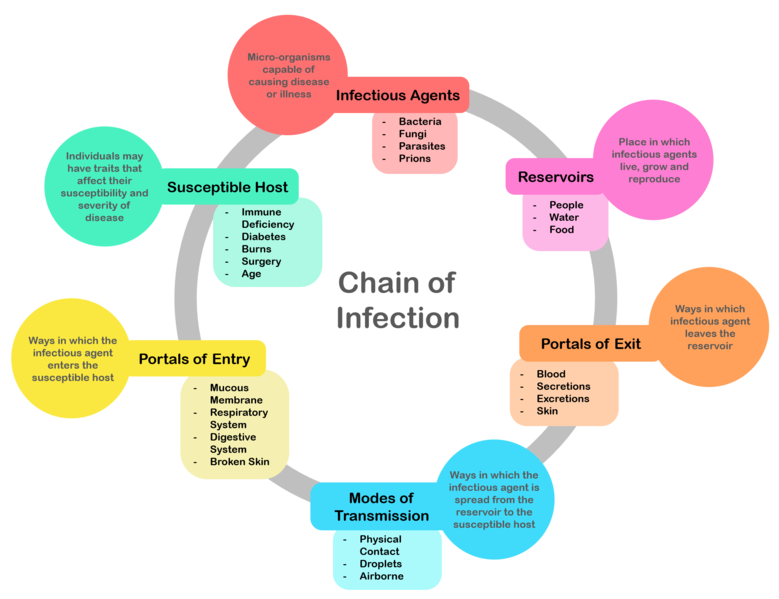All of the Following Prevent and Control Nosocomial Infections Except
Specific written policies and procedures for control of infections in hospital personnel should be readily available. And on the effectiveness of systematic interventions on aerosol.

Nosocomial Infections And Infection Control Medicine
They may occur in different areas of healthcare delivery such as in hospitals long-term care facilities and ambulatory settings and may also appear after.

. Nosocomial infections NI increase morbidity and mortality. CDC uses knowledge gained through these activities to detect infections and develop new strategies to prevent healthcare. Hospital acquired infections HAIs is a major safety concern for both health care providers and the patients.
The CDC guidelines for preventing the spread of VRE include recommendations on the prudent use of vancomycin an educational program on VRE for hospital personnel routine testing of all enterococci isolated from blood and sterile body sites except urine for vancomycin resistance screening of all enterococcal isolates for vancomycin resistance if VRE are. In March and April 2010 data were prospectively recorded from all inpatients at the Hannover Medical School Germany except those treated in the pediatric psychosomatic and. 15 16 17 Strict infection control precautions are considered critical to prevent spread within.
Studies of their prevalence in single institutions can reveal trends over time and help to identify risk factors. Peer Review reports Background. Mng Pert TB HAV HBV HIV SURVEILLANCE Nosocomial infection.
For the prevention and control of nosocomial infections via the aerosol route more research is needed on identifying settings medical procedures or equipment that may be associated with an increased risk of aerosol transmission including defining which procedures are aerosol-generating. The results of the CDC Study of Efficacy of Nosocomial Infection Control suggested that 6 of all HAIs could be prevented by minimal infection control efforts and 32 by well organized and highly effective infection control programs 29 30A later review estimated that as many as 65 to 70 of cases of catheter-associated infections and 55 of cases of surgical site infections. Nosocomial infections also referred to as healthcare-associated infections HAI are infections acquired during the process of receiving health care that was not present during the time of admission.
The prevention and control measures for the COVID-19 pandemic have reduced the nosocomial infection in almost all departments except the ICU mainly regarding respiratory gastrointestinal and oral infections while catheter-related infections did not show any differences. All of the following prevent and control nosocomial infections except. Handwashing is the single most important procedure for preventing nosocomial infections.
CDC provides national leadership in surveillance outbreak investigations laboratory research and prevention of healthcare-associated infections. While it is impossible to prevent every nosocomial infection here are. 1 A hospital-acquired infection is a type of healthcare-associated infection and refers specifically to.
Handwashing is defined as a vigorous brief rubbing together of all surfaces of lathered hands followed by rinsing under a stream of water. Thus it is important to consider which routine practices to follow and why. According to the Centers for Disease Control and Prevention CDC about 3 of hospitalized patients developed a healthcare-associated infection in 2015 about 1 in 31 or 687000 patients in total.
Nosocomial infections or that occur as a result of healthcare interventions known as iatrogenic infections. A infection control programs in hospitals b patient isolation procedures c proper education of staff d uncontrolled contamination in hemodialysis equipment. About 72000 patients with these infections died while hospitalized.
The Infection Control Assessment Tool ICAT is designed to facilitate the identification control and prevention of nosocomial infections through an easily-administered and scored instrument that highlights areas of concern and suggests economical improvements within hospitals. For all infections except pneumonia the risk of developing a secondary bloodstream infection also varied. Healthcare-associated infections HAI are a threat to patient safety.
Initial job orientation and ongoing in-service education should include the infection control aspects of personnel health and the proper use of the personnel health service. Scope of Infection Control Prevention of Hospital Acquired Nosocomial Infections STANDARD PRECAUTIONS Handwashing Barrier precautions Sharps disposal ISOLATION PRECAUTIONS EMPLOYEE HEALTH CD Reporting HBV screening immunization BBFE TB MMR Varicella Work restriction Prophylactic Rx. The results of the CDC Study of Efficacy of Nosocomial Infection Control suggested that 6 of all HAIs could be prevented by minimal infection control efforts and 32 by well organized and highly effective infection control programs 26 27A later review estimated that as many as 65 to 70 of cases of catheter-associated infections and 55 of cases of surgical site infections.
Considering morbidity mortality increased length of stay and the cost efforts should be made to make the hospitals as safe as possible by preventing such infections12These guidelines have been developed for health care personnel involved. Up to 70 of hospitalized RSV infections on hematologyoncology wards are considered nosocomial. Healthcare-associated infections may become evident after a person leaves the healthcare facility.
The probability of developing a secondary bloodstream infection also varied significantly with the primary site of infection from 31 for incisional surgical site infection to 95 for organspace surgical site infection p 001. Infection prevention and control routine practices should be used to prevent exposure to blood body fluids secretions excretions mucous membranes non-intact skin or soiled items PIDAC 2012. All clients can potentially be infectious.

Nosocomial Infection What Is It Causes Prevention And More Osmosis

Development And Validation Of A Competency Evaluation Model For Hospital Infection Prevention And Control Practitioners In The Post Pandemic Era A Mixed Methods Study Journal Of Hospital Infection

0 Response to "All of the Following Prevent and Control Nosocomial Infections Except"
Post a Comment